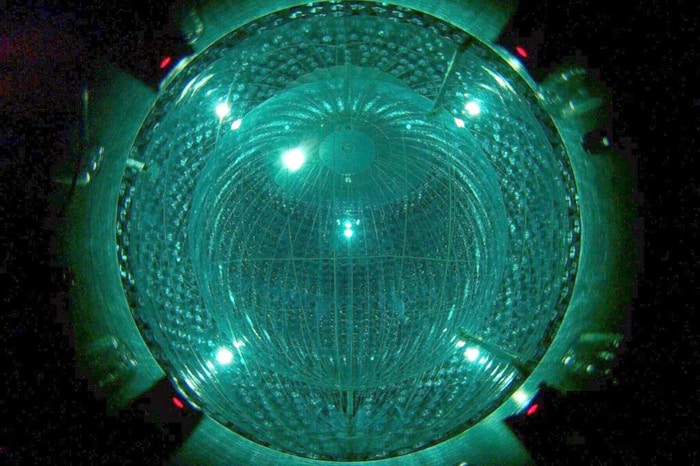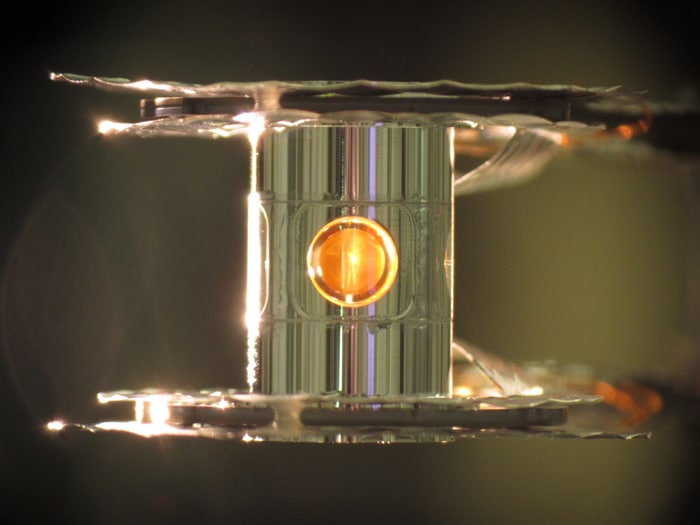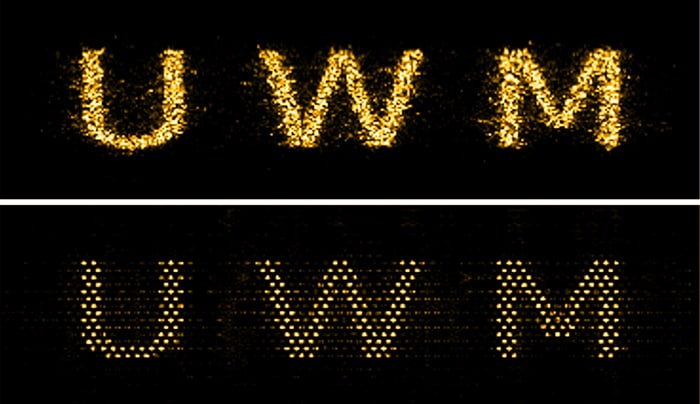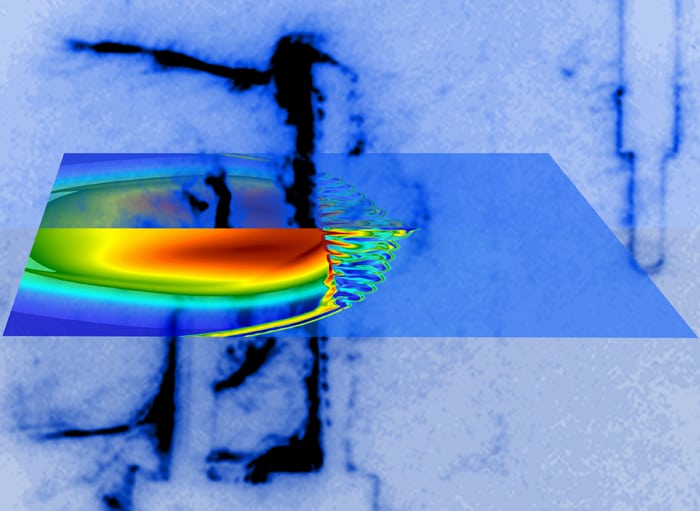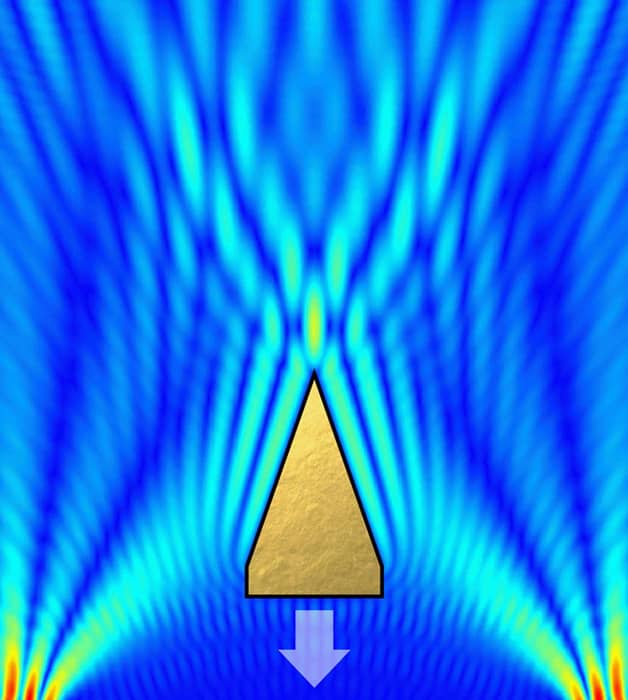The Physics World 2014 Breakthrough of the Year goes to ESA’s Rosetta mission for being the first to land a spacecraft on a comet. Nine other achievements are highly commended and cover topics ranging from nuclear physics to acoustics

History was made at 15:35 GMT on 12 November 2014 when the Philae module touched down on the surface of 67P/Churyumov–Gerasimenko, a comet 511 million km from Earth and hurtling towards the inner solar system at nearly 55,000 km/h. The module bounced twice before coming to rest, and then began collecting data, which has now been sent back to Rosetta scientists for analysis. The landing followed a seven-hour journey for Philae after it separated from the main Rosetta spacecraft. Launched in 2004, Rosetta itself reached the comet after completing a journey of 6.4 billion km that involved three gravity-assisted fly-bys of Earth and one of Mars (see “Rosetta scientists land probe on comet for first time”).
By landing the Philae probe on a distant comet, the Rosetta team has begun a new chapter in our understanding of how the solar system formed and evolved – and ultimately how life was able to emerge on Earth. As well as looking forward to the fascinating science that will be forthcoming from Rosetta scientists, we also acknowledge the technological tour de force of chasing a comet for 10 years and then placing an advanced laboratory on its surface.
The mission was not without its problems. Despite landing in an awkward position where its solar panels do not currently receive enough sunlight to power its instruments, Philae managed to complete all of its planned measurements on battery power alone. The lander was also not able to secure itself to the comet surface as planned, however it did manage to drill into the surface and acquire a sample for analysis.
Organic molecules and dust-covered ice
Preliminary analysis of data sent back from Philae’s Cosac instrument suggests that there are carbon-based organic molecules on the comet. This could prove to be very important information for scientists studying conditions on the very young Earth, which is believed to have been regularly bombarded by comets. The lander’s Mupus instrument was also able to hammer at the comet’s surface, which we now know is covered by a layer of dust about 10–20 cm thick on top of an unexpectedly hard material thought to be water ice.
The instruments aboard the main Rosetta spacecraft have also made important contributions to our understanding of the solar system. Indeed, only this week, scientists using the ROSINA mass spectrometer discovered that the ratio of deuterium to hydrogen in the comet is much greater than that found on Earth (see “Asteroids, not comets, gave Earth most of its water”). This adds strength to the growing body of evidence that the water on Earth was delivered not by comets, as previously thought, but by asteroids.
At 14:00 GMT today, Rosetta mission manager Fred Jansen joined physicsworld.com editor Hamish Johnston in a Google Hangout (see video above) to accept the award and share his unique insights into the mission and the science that it is undertaking. In the video below, Hamish Johnston and colleague Tushna Commissariat explain why Rosetta was chosen as this year’s winner.
The top-10 breakthroughs were chosen by a panel of six Physics World editors and reporters, and the criteria for judging the top 10 included
- fundamental importance of research;
- significant advance in knowledge;
- strong connection between theory and experiment; and
- general interest to all physicists.
Now for our nine runners-up breakthroughs, which are listed below in no particular order.
Quasar shines a bright light on cosmic web
To Sebastiano Cantalupo, Piero Madau and Xavier Prochaska of the University of California Santa Cruz in the US, and Fabrizio Arrigoni-Battaia and Joseph Hennawi of the Max-Planck-Institut für Astronomie in Heidelberg, Germany, for using the radiation given off by a quasar to catch the first glimpse of a filament of the cosmic web.
Matter in the universe is not uniformly distributed and exists in a web of filamentary structures with intervening voids. This web is thought to have formed about 380,000 years after the Big Bang and its presence is a widely accepted theoretical prediction. While we can see matter where it has agglomerated into dense objects such as galaxies, astronomers had not seen the whispy filaments of cold gas. Now, Cantalupo and colleagues have spotted radiation emitted by this gas when it absorbs ultraviolet light emitted by a quasar. The research already suggests that the filament is more “lumpy” than expected, and future measurements using other quasars promise to give much more information about the early universe.
Neutrinos spotted from Sun’s main nuclear reaction
To the Borexino collaboration, for being the first to detect neutrinos from the main nuclear reaction that powers the Sun.
Nearly all of the energy generated in the Sun involves a chain of nuclear reactions that begins with two protons fusing together to form deuterium along with a positron and a low-energy neutrino. Calculations predict that about 60 billion of these neutrinos pass through a square centimetre on Earth every second, but low-energy neutrinos are particularly difficult to detect and so the theory could not be verified. Now, deep under the Gran Sasso mountain in Italy, some of these neutrinos have been detected by spying the flashes of light that occur when the neutrinos collide with electrons in a giant tank of liquid. The Borexino team was not actually expecting to see these neutrinos, but its detector was so well built that the researchers managed to measure a flux of 66±7 billion neutrinos per square centimetre, confirming the long-established theory of solar fusion.
Laser fusion passes milestone
To Omar Hurricane and colleagues at the National Ignition Facility (NIF) of the Lawrence Livermore National Laboratory and the Los Alamos National Laboratory in the US, for being the first to obtain a “fuel gain” of greater than one in a laser-driven nuclear-fusion experiment.
Nuclear fusion promises to deliver vast quantities of clean energy, but physicists working on various experiments have made very slow progress towards this goal. Now, Hurricane and colleagues have used NIF’s ultra-powerful laser to crush tiny pellets of deuterium–tritium fuel to produce more energy from fusion reactions than was deposited in the fuel. This comes after a five-year struggle to boost the amount of fusion energy given off in the process. The team focused on achieving a stable compression of the pellets, and on one occasion was able to achieve more than 2.5 times fusion energy out than laser energy in. Much of this energy is in the form of “alpha-particle heating”, which is essential to achieve “ignition”, whereby energy released from fusion causes more fuel to fuse. Although still far from the long-sought-after goal of ignition, the latest results are an important step towards fusion energy.
Electrons’ magnetic interactions isolated at long last
To Shlomi Kotler, Nitzan Akerman, Nir Navon, Yinnon Glickman and Roee Ozeri of the Weizmann Institute of Science in Israel, for being the first to measure the extremely weak magnetic interaction between two single electrons.
Since the 1920s, physicists have known that the electron possesses an intrinsic spin angular momentum and associated magnetic moment. Although researchers have measured the magnetic field of an individual electron, the magnetic interactions between two electrons have proved much more difficult to observe. Magnetic interactions are at their strongest when two electrons are separated by atomic-scale distances, but cannot be measured because other forces dominate the scene. While these other effects weaken as the electrons move further apart, so does the magnetic interaction, which is then lost in noise. Kotler and colleagues overcame these problems by putting two electrons in a long-lasting entangled state, which guarantees a low-noise environment. They were then able to measure the force between the electrons by using a laser to determine whether the electron spins were parallel or antiparallel.
Disorder sharpens optical-fibre images
To Arash Mafi and colleagues at the University of New Mexico, University of Wisconsin-Milwaukee, Corning Inc. and Clemson University, all in the US, for using the phenomenon of “Anderson localization” to create a better optical fibre for transmitting images.
Disorder in an optical fibre usually blurs transmitted images, but Mafi and colleagues have shown that by putting the right kind of disorder in the right place, the ability of a fibre to transmit sharp images can be enhanced. Indeed, their prototype produced a sharper image than the best available commercial imaging fibres. The technique involves using Anderson localization, whereby light will not propagate through a medium with a certain degree of disorder. The team created a fibre made of 80,000 strands of two different materials that are positioned randomly next to each other. The result is disorder in the directions transverse to the length of the strand and order in the direction that the light propagates.
Data stored in magnetic holograms
To Alexander Khitun and Frederick Gertz at the University of California Riverside in the US, and A Kozhevnikov and Y Filimonov of the Kotel’nikov Institute of Radioengineering and Electronics in Russia, for creating a new type of holographic memory device based on the interference of spin waves.
Holography involves reflecting a beam of light from a 3D object and recording the interference pattern that occurs when it is mixed with an identical beam that did not strike the object. It has the potential to store and retrieve large amounts of information in a very efficient way, but the storage density is limited by the wavelength of the light. The spin waves used in Khitun and colleagues’ magnetic holography device have much shorter wavelengths than visible light, and could therefore be used to store data at higher densities. The prototype device comprises two tiny magnets connected by magnetic wires. Data are saved by sending large-amplitude spin waves through the wires to flip the orientations of the magnets. Data are read by sending smaller-amplitude waves through the device and measuring how they interact with the magnets.
Lasers ignite ‘supernovae’ in the lab
To Gianluca Gregori and Jena Meinecke of the University of Oxford in the UK and an international team, for using one of the world’s most powerful laser facilities to create tiny versions of supernova explosions in the laboratory.
Supernovae are massive stellar explosions that leave behind hot, dense clouds of dust and gas that are often beautiful in appearance. One particular remnant, Cassiopeia A, has long puzzled astronomers because of its irregular knotty structure that suggests the presence of very strong magnetic fields. This supernova was simulated by Gregori, Meinecke and colleagues, who fired three laser beams onto a tiny carbon rod in an argon-filled chamber. The exploding rod creates an asymmetric shock wave that expands outwards through the argon gas, much like a real supernova in space. A plastic grid, which simulated a “lumpy” distribution of gas in the region of the supernova, was placed in the path of the shock wave, and the result was strong magnetic fields similar to those observed in Cassiopeia A. The technique could also be used to simulate a range of astrophysical processes, say the researchers.
Quantum data are compressed for the first time
To Aephraim Steinberg and colleagues at the University of Toronto, Canada, for being the first to demonstrate a quantum analogue of data compression in the lab.
Conventional data-compression schemes cannot be applied to quantum information because they involve measuring the values of the data bits to be compressed – a process that destroys quantum information. In 2010, however, physicists in the Czech Republic worked out that a string of identically prepared quantum bits could be compressed, albeit not as tightly as conventional data. Now, Steinberg and colleagues have done this in the lab, and have squeezed the quantum information carried by three photon-based quantum bits into two. The technique could pave the way for a more effective use of quantum memories – which are not easy to create – and offers a new method of testing quantum logic devices.
Physicists sound-out acoustic tractor beam
To Christine Démoré and Mike MacDonald of the University of Dundee in the UK, Patrick Dahl and Gabriel Spalding of Illinois Wesleyan University in the US, and colleagues, for creating the first acoustic “tractor beam” that can pull an object by firing sound waves at it.
A staple of science fiction, a tractor beam seems to defy physics by pulling an object towards the source of an outgoing beam that carries momentum. The acoustic tractor beam built by Démoré, Dahl and colleagues involves firing two beams of ultrasonic waves at an object. The beams have circular wave fronts that curve around the direction of propagation and so carry angular momentum. When the wave front strikes the target, the angular momentum is redirected as regular momentum. Some of this momentum will be redirected in directions such that the result is a net inward force on the object, pulling it towards the source. The ultrasonic beams were created using a commercial array of ultrasound sources, and the technique could have a range of applications in medicine. These include manipulating objects, fluids and tissue inside the body, and delivering encapsulated drugs to the exact location in the body that requires treatment.
